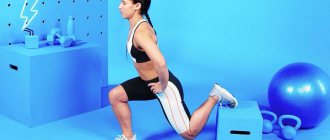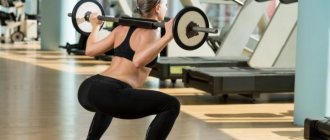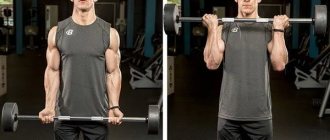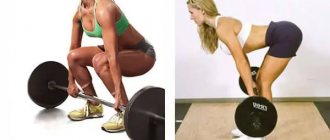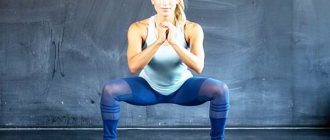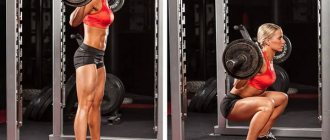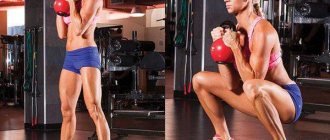The Smith machine kneeling squat is an exercise in the fitness bikini arsenal. It specifically works the gluteal muscles and minimally involves the hips. There is something similar in shaping, only without the weights. The movement is popular among practitioners for aesthetics, and requires high-quality execution. If you do it incorrectly, you can get injured, despite the ease of the exercise itself.
Execution technique
Original
- Set the bar of the machine at a height at which it will be convenient to remove the weight if you are kneeling;
- Lay down the rug;
- Place your knees hip-width apart and slightly wider, pointing your hip bones to the sides;
- Get down on your knees;
- Place the crossbar of the exercise machine in the middle of the trapezoid;
- Tighten your back, lower your shoulder blades towards your pelvis, tighten your stomach;
- Rotate the Smith Bar by hand and remove the weight from the supports.
Movement
- Lower your buttocks between your shins, as if squatting from your knees;
- Don't point your knees forward;
- Choose a comfortable amplitude at which the ligaments do not hurt;
- Perform the reverse movement by extending the hip joint;
- At the top point, statically tense your buttocks if this does not cause discomfort;
- Do not relax your stomach throughout the exercise.
Smith Kneeling Barbell Squats
Attention
- The knees should be slightly pushed forward, and not directly under the bar. This will help avoid ACL injury;
- Do not direct your thighs parallel to each other and forward; this position creates a dangerous load on the knee and hip joints;
- The abs should be kept contracted and the stomach tucked. Relaxing the muscles in this case does not help the process much. On the contrary, it can cause injury;
- Don't relax your back, don't lower your head to your chest, and don't look at the floor.
Features of squats in the Smith machine and their advantages
The Smith machine allows you to most effectively and, at the same time, safely load your legs and buttocks, while also affecting other muscle groups. This is especially true when girls do these exercises. It is not necessary for them to work with a barbell, and it does not make any sense, but getting injured will not be difficult.
At the very beginning of sports, almost all muscle groups, including the legs, are not ready for this, especially when performing classic squats. To begin with, you should just do squats and only then begin additional loads. An empty bar is great for this. It will be especially difficult for those who have ignored sports in their lives. Even if an empty bar is used, horizontal movements of the entire body, including the legs, pelvis and spine, are possible, which can lead to loss of balance and subsequent injuries. The Smith simulator is different in that it does not allow the body to fall in different directions, protecting the athlete from surprises.
The process of squatting in a Smith machine is accompanied by a number of advantages. For example:
- Doing squats in this machine is best for those who have just started playing sports. Having mastered squats in the machine, it will be easy to move on to exercises with free weights.
- You can work on the simulator without a belayer, which is needed when working outside the simulator. The athlete can fix the bar in any position at any time, without outside help, saving himself from unnecessary stress.
- It's almost impossible to lose your balance while doing Smith machine squats. The bar not only provides additional weight for the athlete, but also a fulcrum. Therefore, all that remains is to do the exercises without worrying about your stability.
- The Smith machine will allow you to perfect your squat technique.
- Those athletes who have problems with their knees should not exercise with free weights, but on the Smith machine they are welcome. Here you can adjust the depth of squats and the position of your legs.
- The Smith machine allows you to do other exercises aimed at training other muscle groups, which indicates the high effectiveness of this device.
- It is almost impossible to get injured here, so the Smith machine is a great option for beginners.
Recommendations
- There is an effective range of motion in this exercise. If you want to stick with it, lower your buttocks completely to the floor. You won't be able to stretch the muscle if you sit on your calves. For this reason, the movement is not suitable for people with large hamstrings;
- You can either stretch your feet completely or put your foot on your toes. If you experience discomfort, take off your shoes, it will be easier;
- The bar should not be placed high on the neck;
- If you don't feel the strain, you can do a couple of sets with a rubber shock absorber around your hips;
- Lift from the bottom position quickly, but lowering can be made longer
Types of squats
Classic squats with a barbell on the shoulders
Designed for the development of quadriceps, buttocks, and spinal stabilizer muscles. This technique allows you to constantly increase the degree of load, so only trained athletes should perform this type of squats. You can perform squats at different depths.
To the parallel. This option is the least dangerous for the knee joints and lower back. The lowest point of a squat is the moment when the pelvis reaches the level of the knees and the thigh becomes parallel to the floor.
Deep squats. This type requires flexible muscles, ligaments and sufficient joint mobility
The knee joints are subject to a lot of stress, so it is important to maintain the correct squatting technique. This option puts more strain on the gluteal muscles, due to their maximum extension and greater range of motion.
Front Squats
Such squats shift the center of gravity from the heels to the toes, thereby placing a greater load on the quadriceps of the thigh.
Squats with dumbbells or kettlebell
These types of equipment make it possible to perform squats for those who are not recommended to receive a compression load on the spine, this is associated with various injuries and diseases of the spine.
The weight is held in the center with both hands;
and dumbbells along the sides of the thighs.
Wide leg squats (sumo)
Allows the development of predominantly the entire adductor (inner) surface of the thigh. The atonic state (weakness) of the adductor muscles does not make it possible to fully perform all types of squats and keep the knees at one point, so the exercise improves their stabilizing function.
But girls should not get carried away with this type of squats, as it develops the volume of the adductor muscles, which makes the look less aesthetic.
Narrow leg squats
This option develops the outer thigh (abductor muscles). This is especially necessary for those who want to achieve impressive volumes of the quadriceps muscles. The buttocks work to a lesser extent in the exercise, since the squat cannot be performed deeply.
Plie squats
Similar to the sumo technique, plies maximize the development of the adductor surface of the hips. The feet are placed as wide as possible, the knees and toes are turned apart.
Single leg squats
This technique is performed with a wide stance of the legs without turning the toes, the feet are parallel to each other. When squats, the center of gravity shifts to one leg, bringing one knee to a right angle, while the other remains straight. The technique is complicated by the fact that the load falls on only one leg, and not on both at the same time. This technique develops not only the adductor, but also forms the abductor surface of the thigh.
Sissy squats
Performed with dumbbells or without weight. The peculiarity of the exercise is that when squatting, only the knee joint bends, and the hip joint remains motionless, maintaining the position of the hips and torso in the same plane. The lower parts of the quadriceps develop to a greater extent.
Pistol
It is performed on one leg; when squatting, the joints of the legs are subjected to a large load, therefore, in order to develop coordination and strength of the leg muscles using this technique, it is necessary to have high flexibility of the ligamentous apparatus.
Smith machine squats
They allow you to shift the main part of the load from the back muscles to the legs, allowing you to develop your hips and buttocks without compression of the spine. Foot placement and bar position are similar to barbell squats.
Hack squats in the machine
The exercise is performed in two ways of placing the feet - medium and wide. A special simulator shifts part of the load from the legs to the back. The exercise can also be performed with a barbell behind your back.
Flaws
- Cannot be used as an exercise for building muscle mass, as it does not allow the use of significant weights;
- Not recommended for those with problems with the spine and joints;
- Can cause ACL injury, especially if the ligaments are overloaded with a large amount of cardio and the body as a whole is depleted by diet;
- Not available for large hamstrings or poor mobility;
- Cannot replace basic exercises for those who are underweight;
- Carries a high risk of injury if performed carelessly;
- It can provoke inflammatory processes in the hip joints, especially if the athlete performs a large volume of training load on the buttocks.
Inclusion in the program
You should not include this movement in the training process more than once a week. The reason is increased load on the ACL. It's best to do knee squats on a day when you don't squat or press your legs.
Ideal - after Romanian deadlifts with medium weight as 2-3 exercises. You should not perform the movement in a power mode; it is better to do 8-12 repetitions in 3-4 approaches.
The movement should be performed alternating with a front-loaded kneeling squat (holding a dumbbell on the chest). This will help protect the ACL from overload and diversify your training.
Contraindications
- Any injuries to the ankles, feet, cruciate ligaments of the knee joint, kneecaps and legs;
- Inflammatory processes in the pelvic organs;
- Weak mobility of the ankles and hips;
- Pain and discomfort in the starting position;
- Weak core muscles.
In general, the exercise is not intended to be emphasized or progressed in lifting weights. It just diversifies the training.
Black list of exercises for the buttocks! (Part 1)
Igor August 10, 2020
How to do classic squats with a barbell?
Step by step basic technique
- Before the approach, prepare mentally, focus and concentrate on the weight you are lifting.
- Before squats, warm up your body with cardio exercises. The first set begins with several approaches with minimal weights.
- Approach the barbell located at the level of your collarbones. Grasp the bar with a straight closed grip. Choose a comfortable width for your palms, usually slightly wider than your shoulders: this way your shoulder blades will remain retracted and your back straight throughout the entire approach. If your shoulder joints are tight, spread your arms wider, although this grip increases the likelihood of losing balance.
- Squeeze the bar tightly with your palms, bend your knees slightly and step forward. Walk under the barbell, plant your other foot, and lift up until your shoulder blades are together and the bar is resting on your upper back. With the correct technique, the weight will fall on the trapezius muscle and will be supported by the rear deltoids. If there is strong pressure on the vertebrae, return to the starting position and repeat the approach to the barbell.
- Tighten your leg muscles, straighten your knees, and release the weight from the supports. Take a small step back and place your other foot. Take a neutral head position - this makes it easier to keep your lower back arched and reduces the risk of losing balance. Place your feet wider than shoulder-width apart and point your toes slightly out to the sides. Fix the position and concentrate as much as possible before squatting.
- While inhaling deeply, move your pelvis back and spread your knees to the sides. Do not “lean” forward; a natural tilt of the body is enough. A proper squat is like lowering your buttocks onto an imaginary chair. Having descended to the lowest point, immediately rise and exhale the air from your lungs. The lifting technique is by straightening the legs, and not by straightening the back.
Studies from the University of Alabama (USA) and a number of other specialized organizations have not revealed any harm from barbell squats for the knee joints with the correct technique, neither in professional athletes nor in amateurs.
Important nuances
Boom position
If you lower the bar below your back deltoids, the load will shift to your glutes. This method is suitable for girls with light squats, but is not suitable for strength training, as it increases forward bending and the risk of losing balance.
Head position
The head continues the line of the spine. The gaze is fixed straight ahead.
Squat depth
The depth of the squat affects the involvement of the muscles of the lower back and buttocks. It is determined by how much you can arch your spine without lifting your heels off the floor. The deeper the squat, the greater the load on them. Increasing the range of motion increases strength. To gain muscle mass, weightlifters are recommended to go as low as possible to the horizontal position of their hips.
Knee position
The main rule for a safe squat is that the knee joints should not extend beyond the toes, otherwise the knee ligaments will be injured. To do this, the pelvis is pulled back. Practice proper technique without weight before performing an exercise with weights.
Foot position
The wider your legs are, the greater the load on the buttock muscles. When doing strength training, it is recommended to place your feet at shoulder level or slightly wider. The socks are turned in the same direction as the knees.
Weight selection
When selecting weights, they are guided by the rule: for muscle growth, 6-12 repetitions are needed in each approach, and failure should occur on the last two repetitions.
For example, if you are a beginner athlete, then 10 repetitions per set is enough. Try to perform them using the correct technique with a working weight of 40-50 kg - this is a bar with two weights of 10 kg on each side. If failure occurs after the 8-9th squat, the weight is selected correctly. If you completed all 10 squats easily, add a 5 kg plate to each side. Add weight in this manner until you reach failure on the 8th squat.
Front squat
The safest alternative to classic barbell squats. Reduces the level of interarticular tension in the knees by 15% without loss of muscle activity. Stimulates the quadriceps, facilitates back alignment, the squat is effective even with small loads, and allows you to quickly achieve results.
The exercise helps build strength, flexibility and mobility.
The technique differs from the classic one in that the barbell is held on the chest with the elbows raised as much as possible: the humerus should be parallel to the floor.
Squats for older athletes
Additional precautions are required: thorough warm-up, adherence to exercise technique and safety precautions. In this case, injury rates and rehabilitation are the same as for younger athletes.
Dangerous mistakes that cause injuries:
- brush crease;
- rounding of the spine, lack of arching in the lower back;
- lack of tension in the abdominal muscles;
- bringing the knees inward;
- lifting the heels and transferring body weight to the toes;
- lifting the barbell not by straightening the legs at the knees, but by straightening the back;
- small distance between feet.
If you feel pain during exercise, stop exercising, take an anti-inflammatory pain reliever, and refrain from physical activity for 3-7 days. If the pain does not go away, consult a doctor.
